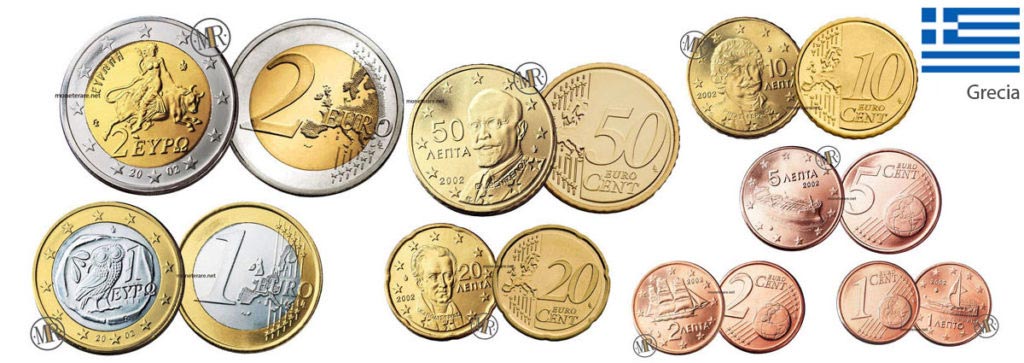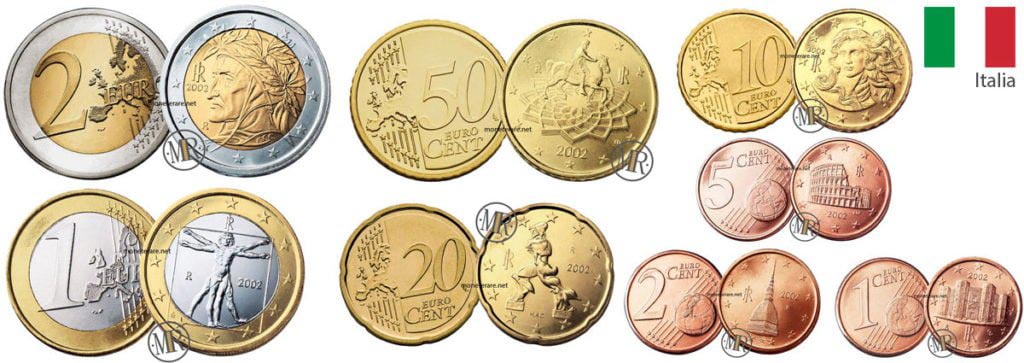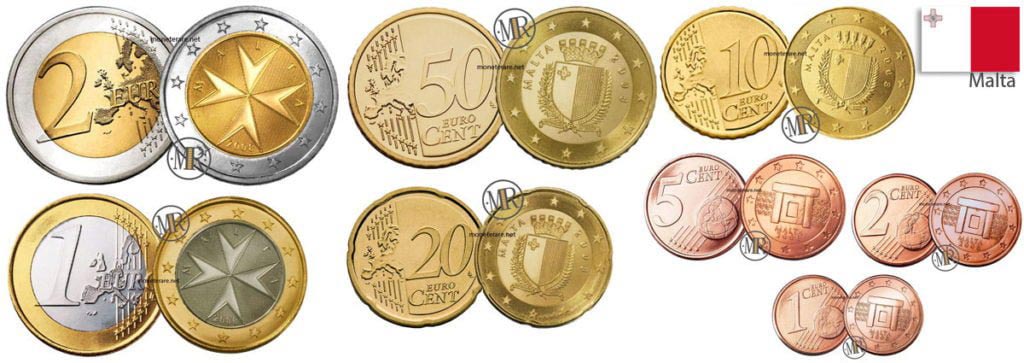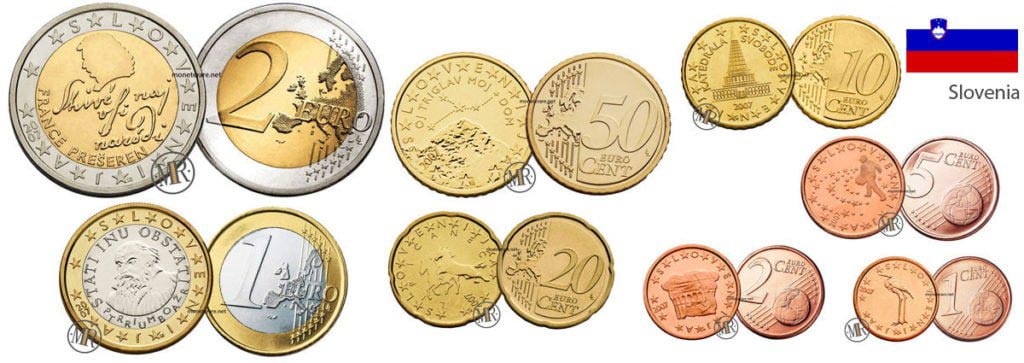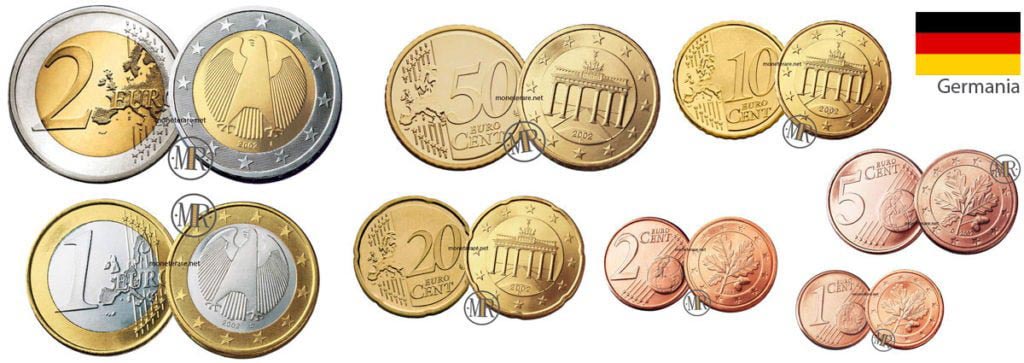In this article we will look at the Euro Austria Coins in order to evaluate not only their technical specifications but also all the characteristics, curiosities and values concerning these coins.
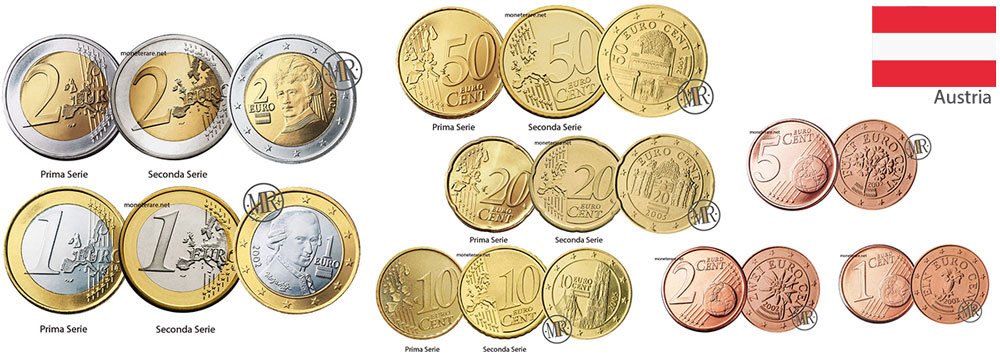
Before doing this, however, it is necessary to take a brief journey through the history of Austrian Numismatics in order to understand how this country actually arrived at the Euro.
History of Austrian Numismatics
Of course, our journey will cover recent history, that is, the history that immediately preceded the introduction of the Single European Currency.
After the end of the First World War in 1918, Austria went through a period in which it was preparing to establish a new republican government. However, the new Republic was faced with various problems due to the post-war situation.
Among these, the devaluation of the “Corona”, at the time, official currency. As a result of this situation, the State decided to introduce a new official currency, the “Shilling”, which came into force on January 1, 1925.
A Shilling was made up of 100 Groschen who are nothing more than our common cents. With the outbreak of the Second World War, however, Austria was annexed in 1938 to the Third Reich and, precisely because of this, the issuance of the national currency ceased.
These were resumed at the end of the conflict and more precisely on November 30, 1945 with the reconstitution of the republic and the introduction of the Shilling.
Then, on January 1, 1999, the Euro officially enters into force with an exchange rate fixed at 1 Euro = 13.7603 Shillings.
On 1 January 2002, the euro banknotes and coins officially enter into force, with a dual circulation phase lasting until 28 February 2002.
Well, after analyzing the history of recent Austrian Numismatics, the time has come to go and explore this fantastic collection by analyzing the various coins one by one.
1 Cent Euro Austria Coins
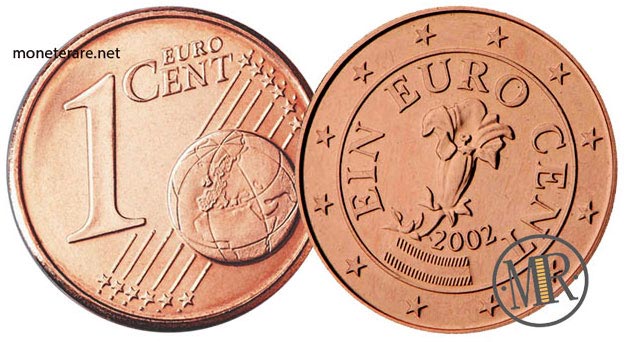
The first coin that we are going to analyse, of course, is the 1 cent Euro Austria coin. Specifically, this coin was made by the author Joseph Kaiser. It was minted in 2002.
On the obverse we can see a wonderful representation of the gentian which indicates the respect for the environment and in general the environmental and ecological policy implemented by Austria.
Around the arch there is the inscription EIN EURO CENT and at the bottom the thousandth of minting accompanied by the Austrian flag. All around are the 12 five-pointed stars representing the European states.
The Verso is that of the 1 euro cent coins, the same for all the countries of the Eurozone.
Let’s now see together the specifications.
- Materials: The material used is an alloy of steel plated with copper (steel 94.35% – copper 5.65%)
- Thickness: The thickness is equal to 1.67 mm
- Weight: The weight is 2.30 g
- Diameter: The diameter is equal to 16.25 mm
- Outline: The contour is completely smooth
- Engraver: Joseph Kaiser
Value and Circulation of 1 Cent Euro Austria Coin
2 Cents Euro Austria Coins
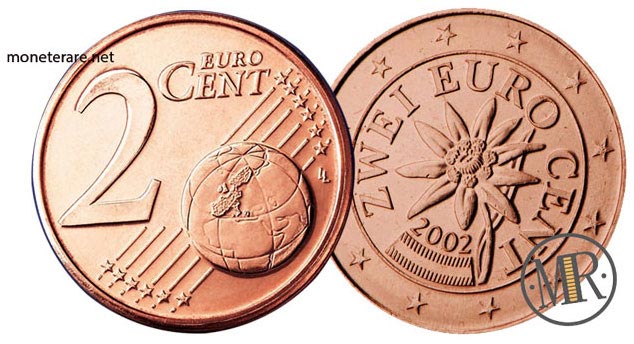
Let’s move on to the second coin in this collection, the 2-cent Euro Austria coin. The author in this case is the same or Joseph Kaiser even if the subject changes. It is coined for the first time in 2002.
In fact, at the obverse side we find the Leontopodium, another plant that indicates the respect for the environment and the environmental policy implemented by Austria. All around the arc we find the inscription ZWEI EURO CENT.
Below are the thousandth of a coinage and the Austrian flag. Surrounding the subject depicted as always we can see the 12 five-pointed stars that represent the European states.
The reverse is the Common Face of 2 euro cents, the same for all countries of the Euro Zone.
Let’s analyze the technical specificities.
- Materials: Also in this case the material and the steel plated with copper (steel 94.35%, copper 5.65%)
- Thickness: The thickness is always equal 1.67 mm
- Weight: Weight increases to 3.06 g
- Diameter: The diameter also increases to 18.25 mm
- Outline: Incused horizontal thread
- Engraver: Joseph Kaiser
Value and Circulation of 2 Cents Euro Austria Coin
5 Cents Euro Austria Coins
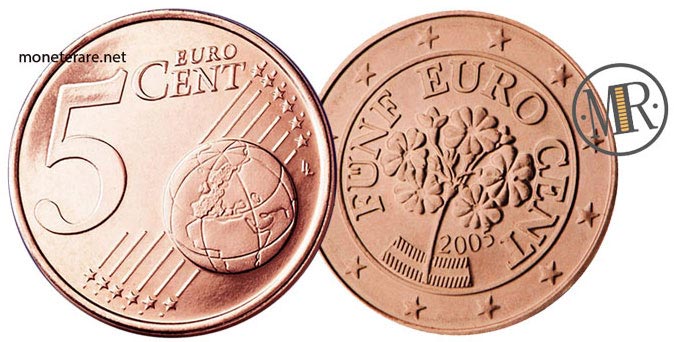
The next coin to be analysed in 2002 are the 5 cents Euro Austria coins. Once again the author is Joseph Kaiser but once again the subject represented is different even if with the same intent.
In fact, at the obverse side we find the representation of the Mountain Primrose, another plant that indicates the respect for the environment that Austria has always shown in the field. Below are once again the thousandth coinage and the representation of the Austrian flag.
Around the subject there is the inscription in large FUNF EURO CENT while all around the coin the classic 12 stars with five points representing the European States.
The reverse is the same for all 5 euro cent coins circulating within the Euro Zone.
Technical characteristics:
- Materials: Once again the material is steel plated with copper distributed as follows: 94.35% for steel and 5.65% for copper
- Thickness: The thickness is always the same or 1.67 mm
- Weight: Weight increases even further to 3.92 g
- Diameter: The diameter is equal to 21.25 mm
- Outline: The contour returns to being completely smooth
- Engraver: Joseph Kaiser
Value and Circulation of 5 Cents Euro Austria Coin
10 Cents Euro Austria Coins
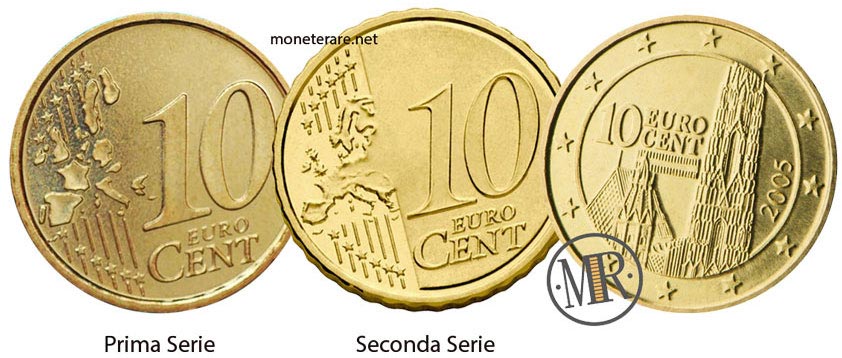
We immediately move on to the next currency, the 10 euro cent Austrian coin. Also in this case the author is the same or Joseph Kaiser. In the first version of 2002 and in the second version of 2008.
On the Obverse we can see a very faithful representation of St. Stephen’s Cathedral in Vienna, made in such a way that the relative detail of the roof of the tower stands out. On the left there is the inscription 10 EURO CENT with immediately under the Austrian flag. On the right instead there is the thousandth of minting.
All around, as for all European coins, there are the 12 five-pointed stars that represent the countries of the European Union.
The reverso is distinguished by the First Series of 2002/2007 which has the old Common Face with all separate countries.
Instead, the Second Series of 2008 uses the New Common Face with the map of the Eurozone represented with the United countries.
But let’s see the technical specifications.
- Materials: The material used this time is Nordic Gold, 89% copper, 5% aluminium, 5% zinc and 1% tin.
- Thickness: The thickness increases to 1.93 mm.
- Weight: Weight also increases to 4.10 g
- Diameter: The diameter decreases slightly to 19.75 mm.
- Outline: The contour is grooved with thick knurling
- Engraver: Joseph Kaiser
Value and Circulation of 10 Cents Euro Austria Coin
20 Cents Euro Austria Coins
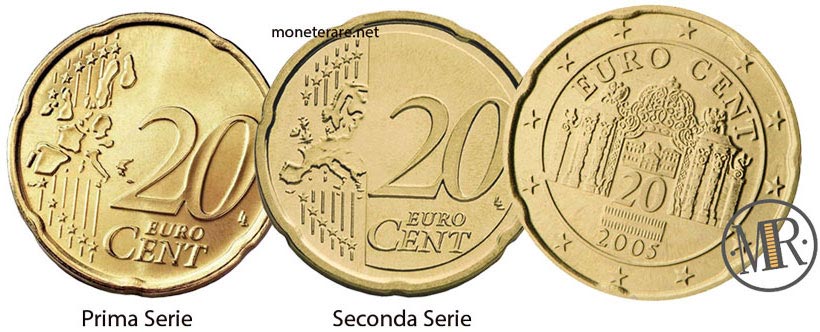
So let’s get to the 20 cents Euro Austria coins. Once again the author is confirmed to be the same as all other coins or Joseph Kaiser while continuing to change the subjects represented. The First Series is from 2002 and the Second Series from 2008.
This time, in fact, on the Obverse we can see the representation of the Belvedere Palace located in the historic center of Vienna and one of the most beautiful princely residences in Europe. Above the palace there is the inscription EURO CENT and immediately below the number 20. Continuing to go down we find instead the Austrian flag and the thousandth of minting.
As usual, all around you can see the 12 five-pointed stars that represent the European countries.
The reverso is characterized by the Common Face and all the 20 eurocent coins of the Euro Zone.
Now, the First Series of 2002/2007 shows the old map of Europe with the European States spaced out.
The Second Series, coined since 2008, uses the New Common Face that sees the Eurozone States united without borders.
We see the coin from a technical point of view.
- Materials: The material used is once again Nordic Gold, 89% copper, 5% zinc, 5% aluminium and 1% tin.
- Thickness: The thickness is 2.14 mm
- Weight: Weight increases a little more to 5.74 g
- Diameter: The diameter is 22.25 mm
- Outline: The contour is characterized by a wide knurling
- Engraver: Joseph Kaiser
Value and Circulation of 20 Cents Euro Austria Coin
50 Cents Euro Austria Coins
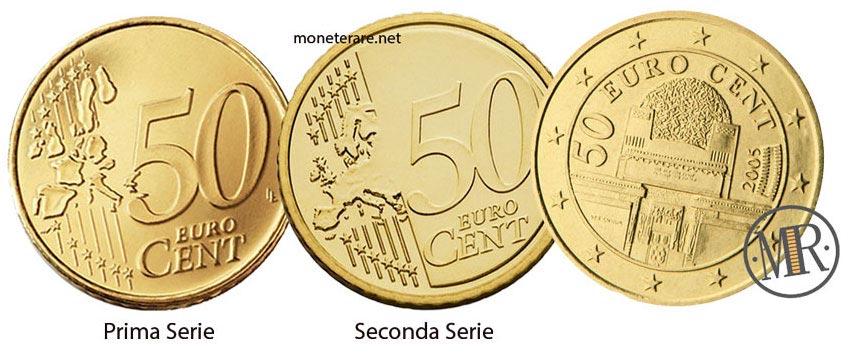
Here we are with the 50 cents Euro Austria coin. The author once again is not even to say Joseph Kaiser who, however, delights in a new representation with regard to this coin. The first series is minted in 2002, the second in 2008.
In fact, the Palace of the Secession in Vienna is represented in the Obverse in memory of the birth of Art Nouveau in Austria and in general of the beginning of a new historical and artistic period. In addition, a symbolic bridge alludes to a new monetary period for the country.
Above, in the form of an arch, there is the inscription 50 EURO CENT, while on the right there is the thousandth of minting and the Austrian flag. All around, as usual, there are the classic 12 five-pointed stars that represent the European countries.
The reverso is instead the same as the other 50 eurocent coins, the Common Face of all the countries belonging to the Eurozone.
As far as the First Series from 2002 to 2007 is concerned, the Old Common Face is used, which represents the map of Europe with the European countries separated from each other.
Instead, the Second Series, of 2008, depicts the New Common Face with the Euro Zone States no longer separated but united with each other.
Let’s also see together the technical characteristics of this coin.
- Materials: Once again we talk about the material used of Nordic Gold consisting of copper for 89% – zinc for 5% – aluminum for 5% – tin for 1%.
- Thickness: The thickness increases a bit to reach 2.38 mm.
- Weight: The weight increases very significantly to 7.80 grams
- Diameter: The diameter is also slightly increased to 24.25 mm.
- Outline: The contour is grooved with thick knurling
- Engraver: Joseph Kaiser
Value and Circulation of 50 Cents Euro Austria Coin
The rare 50 cents Austrian euro coins are those of 2012/2013/2014/2015 their value is between 5€ and 6€
1 Euro Austria
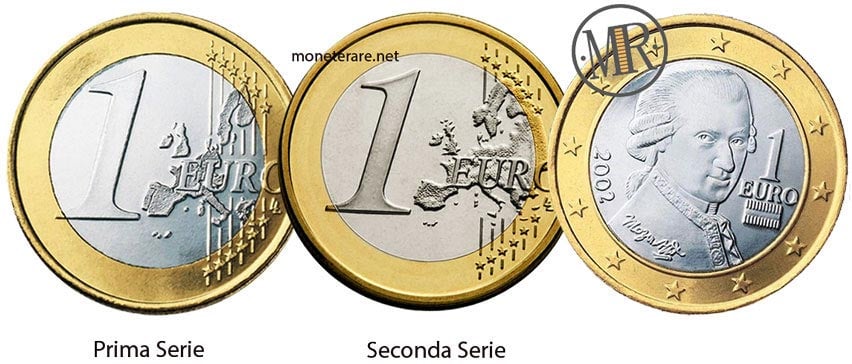
We’ve come to the penultimate coin in this collection. Specifically, we are talking about the bimetallic 1 Euro Austria coin. Also for this one Joseph Kaiser was chosen as author and once again he chose a different subject. First Series of 2002 and Second Series of 2008.
In fact, at the obverse, we can find the wonderful representation of Wolfang Amadeus Mozart, the most famous Austrian composer. On the right shoulder there is the relative engraving signed by Mozart himself.
On the left is placed the thousandth of minting while on the right the writing 1 Euro followed at the bottom by the Austrian flag.
All around once again are placed instead the 12 five-pointed stars representing the European states.
On the reverse there is the Common Face of all European countries.
The First Series (2002/2007), reports the Old Common Face in which you see the European countries separated from each other.
The Second Series, that of 2008, begins to use the New Common Face with the version of the map with the Eurozone States symbolically united without distances.
Let’s also see the specific technical features of this particular currency.
- Materials: As for this coin we are talking about a double material. The external part in fact consists of nickel-brass, that is 75% copper, 20% zinc and 5% nickel. The inner part is instead of copper-nickel or 75% copper and 25% nickel
- Thickness: The thickness decreases a bit to reach 2.33 mm
- Weight: Even the weight compared to the previous coin decreases to 7.50 grams
- Diameter: The diameter also suffers a small decrease to 23.25 mm.
- Outline: The contour is striped discontinuously
- Engraver: Joseph Kaiser
Value and Circulation of 1 Euro Austria Coins
As you can see from the value tables, the most interesting rare coins are:
- 1 Euro Austria 2012 worth 18€
- The 1 Euro Austria 2013 coin, valued at 18€
- 1 Euro Austria 2014, value 11€
2 Euro Austria
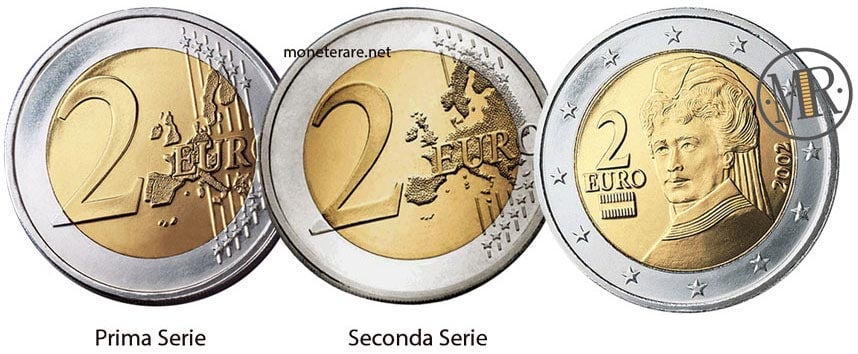
Here we are at the last coin of this very interesting collection. Specifically, of course, we are talking about the 2 Euro bimetallic coin Austria. Also in this case the author is Joseph Kaiser as for all other Austrian Euro coins. The first series was minted in 2002 and the second in 2008.
Remember to have a look at the interesting Austrian commemorative 2 euro coins, they could have a much higher value.
In the Obverse there is a portrait of Berta Von Suttner, a well-known Austrian writer who was also awarded the Nobel Peace Prize in 1905. On the left we find the inscription 2 Euro with immediately under the Austrian flag. On the right instead is placed the thousandth of minting.
Also for this coin there are the 12 five-pointed stars that represent the countries of the European Union.
On the reverse side there is the common face of the 2 Euro coins in use in the European countries.
For the First Series, that of 2002/2007, the Common Face represents the map of Europe with separate European countries.
Then from the Second Series, from 2008, we start to use the New Version of the Common Face with the Euro Zone States all united without distances between them.
Let’s see now the technical specifications also of this last coin.
- Materials: Also in this case we have to talk about a different double material for the inner and outer part. The outside is copper-nickel (copper 75% – nickel 25%), the inside is nickel-brass (copper 75% – nickel 20% – zinc 20%).
- Thickness: The thickness is 2.20 mm
- Weight: The weight is 8.50 g, we are talking about the heaviest coin in the whole collection.
- Diameter: The diameter is 25.75 mm
- Outline: The outline consists of the words 2 Euro followed by three stars. The particularity is that the writing is alternated between straight and upside down
- Engraver: Joseph Kaiser.
Value and Circulation of 2 Euro Austria Coins
The 2 Euro Austria coins 2019 are the rarest, their value is about 12€.
Want to see more Eurocollection coins?
- Two pages you can’t miss: 2 Euro Commemorative Coins and Rare Euro Coins
- The precious Vatican euro coins can be seen here and also the San Marino euro coins
- Here you can see the Malta euro coins and here the Cyprus euro coins.
- Euro coins from Germany can be found here and Euro coins from Estonia and Latvia Euro Coins here.
- Euro coins from France can be found here, as well as Euro coins from Austria.
- Also of great interest are the euro coins from Greece and the euro coins of Luxembourg.
- Here you will find Lithuania Euro coins and Andorra Euro coins
- We also talked about Slovenian Euro coins and Slovakia Euro coins.
- Check also Spanish Euro Coins here and Euro Coins of Portugal here.
- The Netherlands euro coins can be found here and the Ireland euro coins here.
- All precious Monaco Euro coins are here and Belgium Euro coins here


